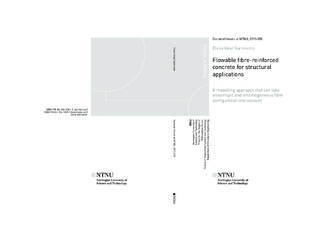| dc.description.abstract | The fibre orientation and distribution in a structural element cast with flowable fibrereinforced
concrete (FRC) is affected by the concrete flow, which can enhance its nonuniform
and anisotropic fibre configuration. The structural behaviour may deviate
substantially, in favourable or unfavourable ways, from behaviour corresponding to a
uniform and isotropic fibre configuration, or from behaviour measured in a material
characterization test.
The aim of this research project was to evaluate the impact of the fibre configuration on
the mechanical behaviour of elements cast with flowable FRC and to provide a
methodology for predicting this effect in their structural behaviour. The experimental
investigation focused on characterizing the fibre volume content and orientation to
make it possible to explain the structural behaviour. The examination was done at two
levels of application: at the full-scale level using structural beams, and at a small-scale
level using test specimens for material characterization.
The analysis of the fibre configuration at the full-scale level confirmed that casting
under full-scale conditions can lead to non-uniform fibre configurations which may be
difficult to foresee in the production stage and may not occur in standard test specimens.
The observed non-uniform fibre configuration in the full-scale beams had a direct
consequence on their mechanical response; the areas with unfavourable orientation and
low fibre content played a decisive role in the crack propagation and reduced the loadcarrying
capacity. These observations suggest that procedures for estimating the
structural performance of flowable FRC need to consider determinations or predictions
of its fibre configuration.
From a design-oriented perspective, one possible approach is to characterize the
material using small-scale standard tests and correct these results for favourable or
unfavourable variations in fibre content and fibre orientation in the full-scale element.
As a more advanced solution, a numerical modelling approach was developed to predict
the mechanical response of a structural element taking its actual fibre configuration into
account. This approach was found to capture the large differences in the loading
capacity of the beams tested, which can only be attributed to the differences in their
fibre configurations.
Incorporating the effect of fibre configuration in the prediction of structural behaviour
will contribute to more reliable and effective use of flowable FRC. In combination with
simulations of casting and non-destructive methods of characterizing the fibre
configuration, this will encourage the use of this material in structural applications. | nb_NO |
